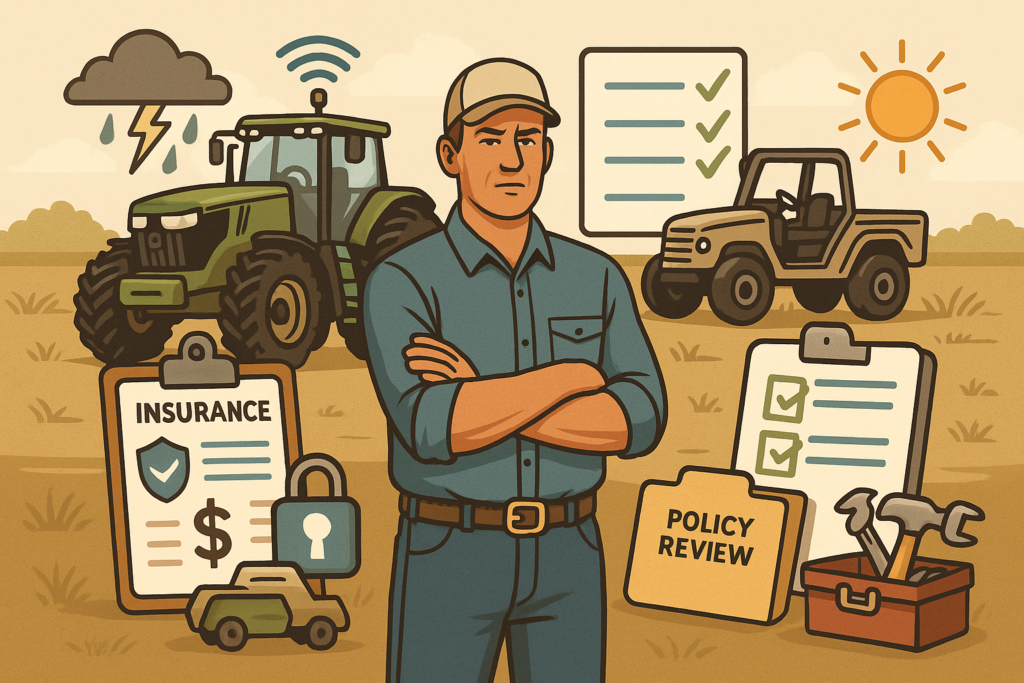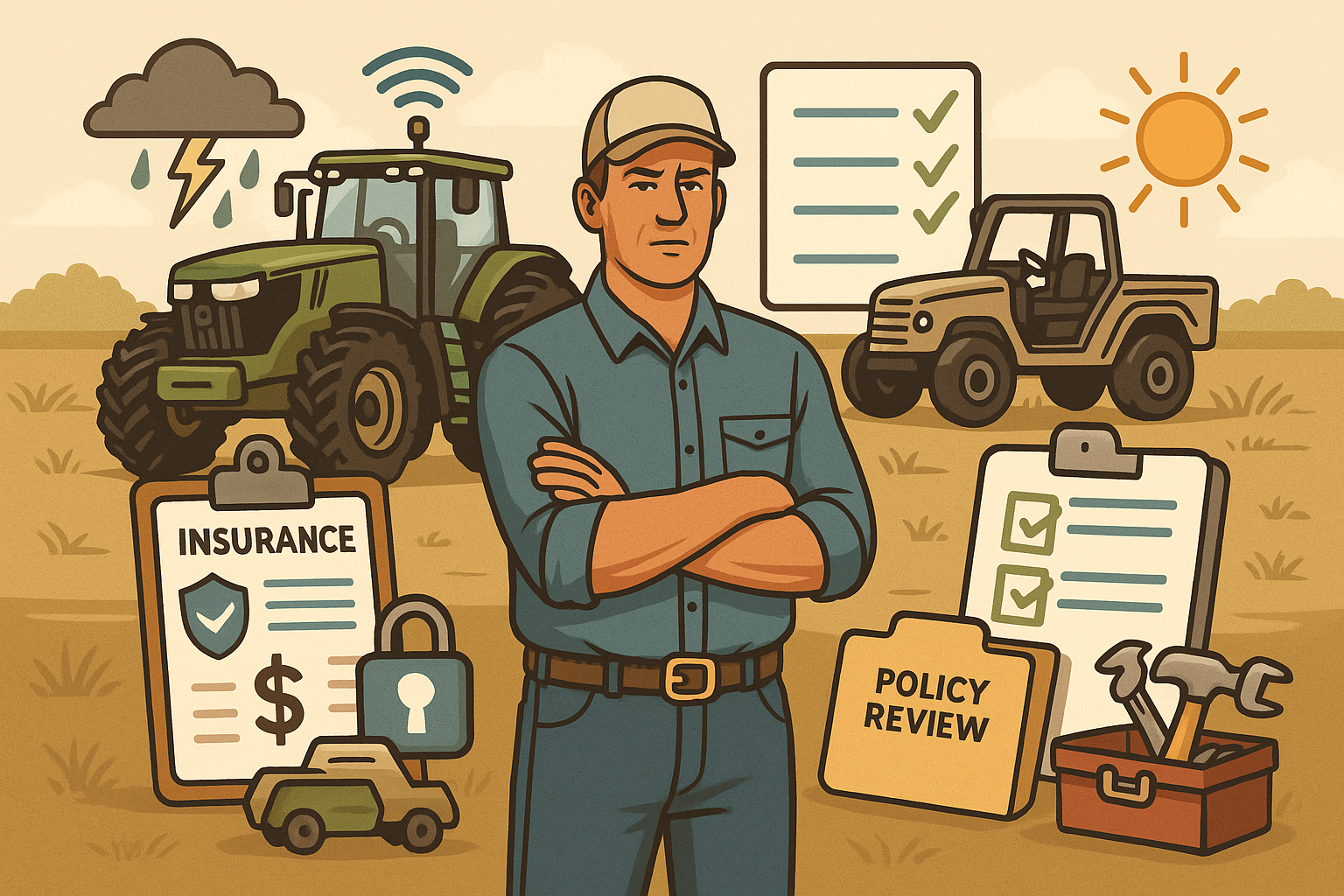Table of Contents
- 1 Understanding Coverage Types
- 2 Assessing Equipment Value and Condition
- 3 Evaluating Policy Exclusions and Limitations
- 4 Considering Geographic and Environmental Factors
- 5 Exploring Technological Advancements in Equipment
- 6 Reviewing and Updating Policies Regularly
- 7 Comparing Insurance Providers
- 8 Understanding the Role of Risk Management
Understanding Coverage Types
The foundation of securing your farm’s future against unexpected financial losses lies in acquiring the right insurance policy for your needs. Farm equipment insurance comes in various forms, tailored to meet the diversified risks associated with agricultural operations. Among the most prevalent types are property damage coverage, which provides compensation for repairs or replacement if your machines are damaged in an accident, vandalized, or destroyed by severe weather conditions; liability coverage, which steps in to cover your legal and financial responsibilities if your equipment injures someone or damages someone else’s property; and theft protection to cover losses stemming from stolen machinery. When researching insurance, it is essential to align your decisions with your farming operation’s unique needs and scale. For example, large commercial farms often need high-limit policies covering an array of specialized equipment. At the same time, smaller family operations may opt for streamlined, budget-oriented coverage that protects essential tools but avoids unnecessary surplus. Careful selection ensures that you maintain vital protection without overpaying for unneeded services. Farmers mindful of their budget constraints can find affordable farm equipment coverage tailored to both standard requirements and evolving risks, keeping costs manageable while shielding their investments. A comprehensive understanding of how each type of coverage works prevents crucial protection gaps, safeguarding your operation’s financial stability during uncertain times.
Assessing Equipment Value and Condition
The value, age, and overall condition of your farm machinery play major roles in determining your insurance premium and the terms of your policy. Equipment with higher values, like GPS-guided tractors or modern combine harvesters, attracts higher premiums due to more expensive replacement costs. By contrast, older or heavily used machines may carry increased premiums or only qualify for reduced coverage, since such equipment is considered more susceptible to malfunctions and breakdowns. Assessing true equipment value is more involved than noting the original purchase price. You must also consider depreciation, pay attention to recent technology upgrades, stay aware of market price trends for machinery similar to that used, and factor in the cost of sourcing equivalent equipment in today’s market.
The process should begin with the creation and maintenance of a comprehensive inventory. This inventory should include photographs, serial and identification numbers, records of maintenance, and notes on modifications and upgrades. Detailed documentation will serve you well if you need to file a claim, as it helps validate your loss and speeds up the insurer’s evaluation and payout process. Additionally, up-to-date records assist in asset management, tax filings, and operational planning by giving you a clearer picture of the investments in your farming machinery. Keeping your inventory current is a proactive step to ensure you’re adequately insured as your equipment ages or as new technologies are incorporated into your operation.

Evaluating Policy Exclusions and Limitations
Though designed to protect, insurance policies are unlikely to cover every possible risk. Common policy exclusions include damage from routine wear and tear, mechanical breakdowns caused by lax or skipped maintenance, and damage from natural disasters such as floods or earthquakes unless you purchase specific coverage for these events. Understanding what your policy does not cover is as important as understanding what it does, so that you can either seek additional protection (through riders or separate policies) or take extra steps to mitigate the excluded risks through careful management and maintenance.
Furthermore, insurance companies will often refuse claims if equipment is found to have been misused, operated in ways not covered by the policy, or left unattended in high-crime locations. Regular, clear communication with your insurance agent about how, where, and by whom your equipment is used will help ensure robust coverage. Detailing how and where machinery is stored, your procedures for routine care and maintenance, and the typical lifespan of your equipment improves your policy’s accuracy and reduces the risk of unpleasant claim denials. Close collaboration with your insurance provider ensures your policy suits your operation’s reality, minimizing the likelihood of facing costly uncovered losses.
Considering Geographic and Environmental Factors
Your farm’s specific location and environmental context directly affect your insurance choices, premium rates, and the types of coverage you need. Farms in regions frequently impacted by severe weather—such as tornado-prone areas, flood zones, or hailstorms—face an elevated risk. Insurers often require additional coverage, higher deductibles, or even impose policy limitations in areas they consider high-risk. Farms near flood plains, brushfire zones, or regions with known geological hazards need to be particularly vigilant, as coverage requirements and costs can escalate rapidly in these environments.
Considering your proximity to essential repair services and emergency response resources is also critical. Farms in rural or remote areas may face longer wait times for repairs, resulting in prolonged business interruptions if essential equipment is damaged and out of service. Such delays can be costly during peak planting or harvesting seasons. By conducting a frank assessment of your environmental and geographic risks—and sharing this information with your insurance provider—you can secure a policy designed to address realistic and location-specific threats. Early identification makes it easier to allocate insurance resources and target preventative measures where they will do the most good.
Exploring Technological Advancements in Equipment
The movement toward advanced technologies is reshaping the agricultural landscape and introducing new risks and insurance considerations. Precision farming equipment, autonomous vehicles, and interconnected machinery equipped with IoT sensors for real-time monitoring are more expensive to repair or replace and vulnerable to risks that older models never faced, such as cyber threats, GPS signal jamming, or software failures. Traditional coverage may not protect against these new threats, making it increasingly important for farmers to partner with insurers who have experience covering technology-driven operations.
Staying informed about technological advancements is not just a matter of maximizing productivity—it also ensures that your investment is properly insured. Ask potential insurance providers about custom endorsements tailored to advanced technology, including protection for electronics, proprietary software, and potential cyberattacks. As your farm adopts more advanced equipment, verify whether your current policies cover losses related to digital malfunctions, data loss, or hacking. Partnering with forward-thinking insurers helps you keep pace with technology while managing the associated risks.
Reviewing and Updating Policies Regularly
Because agriculture is a dynamic and often unpredictable business, insurance needs can change yearly. Perhaps your farm has expanded, new equipment has been purchased, or operational practices have shifted. These changes frequently impact your risk exposure and the adequacy of your current coverage. Scheduling annual reviews with your insurance provider is the most reliable way to ensure your policy keeps pace with your present operation. Update your policy whenever you acquire new assets, retire outdated equipment, or undergo significant business changes.
Internal audits of your assets and regular consultations with insurance professionals should become standard practice for every operation. Such reviews allow you to manage your insurance budget more efficiently and ensure ongoing coverage for all critical assets. Taking these proactive steps significantly reduces the chance of underinsurance—or overpaying for coverage you no longer need—while improving your ability to minimize costly disruptions if an insured event occurs.
Comparing Insurance Providers
Not all insurance providers offer the same protection, expertise, or service level. Before making your selection, investigate several insurers’ reputation and industry experience, focusing especially on their track record with agricultural clients. Review financial health ratings, consult peer reviews, and request detailed explanations of policy features and exclusions. Communication is crucial: Seek providers that offer transparent information, prompt claims servicing, and clarity around policy terms.
Comparing multiple quotes provides you with leverage and clarity. Don’t hesitate to ask about their experience with handling complicated claims, speed of claims resolution, and support during times of crisis. Select an insurance partner—not just a policy—that prioritizes your farm’s unique risks and matches your long-term vision for security and continuity. Good provider relationships are invaluable during negotiations and in cases where you need individualized coverage solutions or assistance with complex claims.
Understanding the Role of Risk Management
Sound risk management is vital for protecting your equipment and maintaining insurance affordability. Simple measures such as adhering to regular maintenance schedules, instituting thorough safety training for all equipment operators, and investing in anti-theft technology significantly decrease chances of loss. Such proactive steps reduce your risk exposure and can result in substantial insurance premium savings. Insurance companies appreciate diligent risk management; some reward it with better policy terms, free services, or premium discounts.
Embedding a safety culture and continuous improvement on your farm protects your workforce and your investment in machinery. Demonstrating your ongoing commitment to prevention through staff training, improved infrastructure, or security upgrades can bolster your insurance applications and renewals. Over time, these steps pay dividends in operational efficiency and greater resilience to loss, keeping your farm robust and better prepared for future uncertainties.




